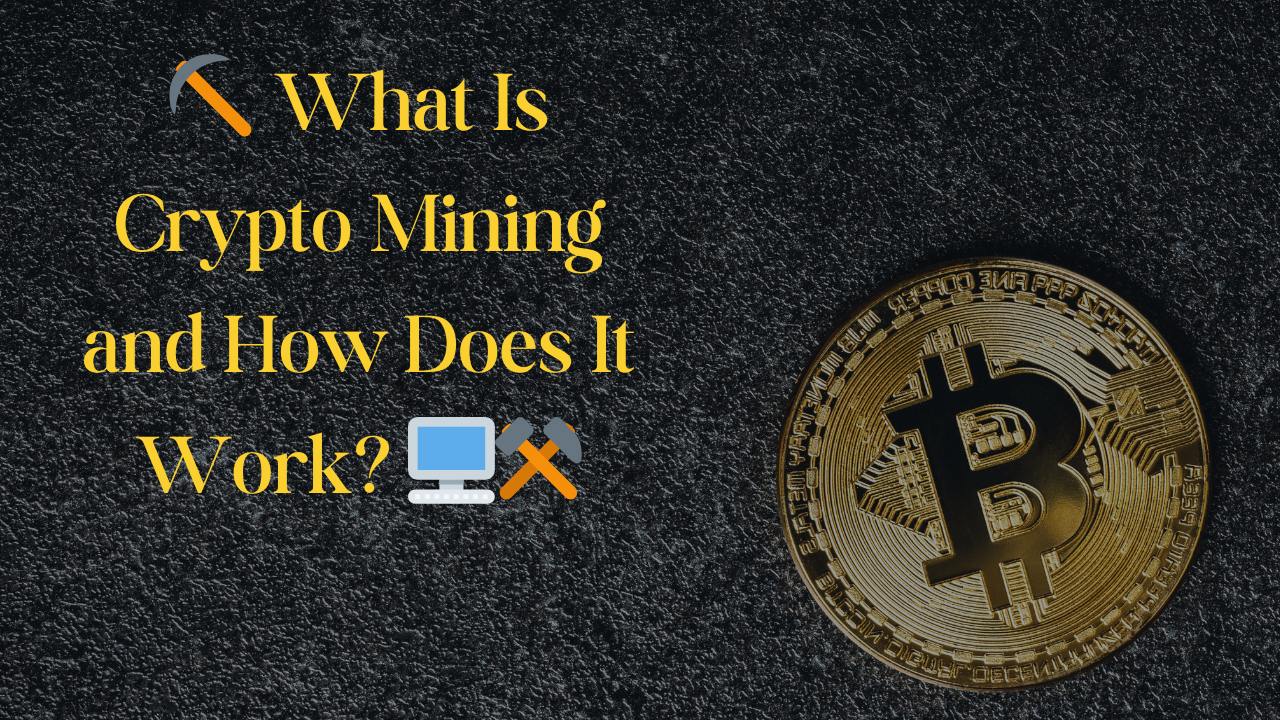⛏️ What Is Crypto Mining and How Does It Work? 🖥️⚒️
2025-04-02 22:52:17.956 +0000 UTC

⛏️ What Is Crypto Mining and How Does It Work?
When people hear the word "mining," they often imagine pickaxes and tunnels—but in the world of crypto, mining means something entirely different. 🪙⛏️ Crypto mining is a foundational process that keeps certain blockchains running smoothly. It creates new coins, verifies transactions, and keeps the entire decentralized system secure. Let’s dive deep into what mining is, how it works, and why it matters. 💡
📖 The Basics: What Is Crypto Mining?
Crypto mining is the process of validating transactions on a blockchain and adding them to a digital ledger. In return for doing this work, miners are rewarded with cryptocurrency—usually in the form of newly created coins and transaction fees. 💵🔗
Mining is critical in blockchains that use a consensus mechanism called Proof of Work (PoW). Bitcoin is the most well-known example, but other coins like Litecoin, Bitcoin Cash, and Monero also rely on PoW. 🧱
🔐 Why Is Mining Necessary?
- ✅ It verifies and secures transactions.
- 🔄 It prevents double-spending (using the same coin twice).
- 📈 It introduces new coins into circulation (like Bitcoin rewards).
- 👥 It maintains trust without a central authority.
🛠️ How Does Crypto Mining Work?
Let’s break down the process of mining step by step:
- 📨 A group of transactions is gathered into a block.
- 🧮 Miners compete to solve a complex mathematical puzzle.
- 🔑 The first one to solve it broadcasts their solution to the network.
- ✅ Other nodes verify the solution. If it’s correct, the block is added to the blockchain.
- 💰 The winning miner earns a reward (block reward + transaction fees).
🔢 The Puzzle (Proof of Work)
The "puzzle" is a hash function—a one-way math function that converts input into a unique string of characters. Miners must find a hash that meets certain conditions (like starting with a number of zeros). This takes a ton of computational power and energy. 🧠⚡
🏗️ What Do You Need to Start Mining?
- 💻 Mining Hardware: ASICs (Application-Specific Integrated Circuits) or GPUs (Graphics Processing Units)
- 🔌 Electricity: Lots of it! Mining consumes serious power.
- 🌐 Internet Connection: To stay in sync with the network
- 👛 Crypto Wallet: To receive your mining rewards
- 🔗 Mining Software: To connect your rig to the blockchain
👥 Solo Mining vs. Mining Pools
🧍 Solo Mining
You mine alone, and if you solve a block, you keep the full reward. But the odds of solving a block are very low without massive power. 🎰
👥 Mining Pool
Miners combine their computing power. If the pool solves a block, rewards are split based on each miner’s contribution. More stable income, less risk. 🤝
🌍 Environmental Impact
One of the biggest criticisms of crypto mining is its energy usage. Bitcoin alone uses more electricity than some small countries. 🏭🌎
However, the industry is evolving:
- ☀️ Mining farms powered by renewable energy (solar, hydro, wind)
- ⚙️ More efficient ASIC hardware
- 🔀 Transition to Proof of Stake in many blockchains (e.g., Ethereum 2.0)
💵 How Much Can You Earn from Mining?
That depends on several factors:
- ⚙️ Hardware power (hashrate)
- 💡 Electricity costs in your area
- 📉 Network difficulty
- 🪙 Price of the coin you’re mining
Online calculators (like WhatToMine) help estimate potential profits. But keep in mind—profits can change fast with market prices. 📊
🚨 Risks of Crypto Mining
- 💸 Upfront hardware and electricity costs
- 🔥 Hardware wear and overheating
- 📉 Market volatility can reduce profitability
- 🧾 Possible tax implications and regulatory scrutiny
⚖️ Is Mining Still Worth It?
Mining can still be profitable—especially in areas with cheap electricity or when joining a mining pool. But it’s become more competitive than ever. For many, buying crypto directly or staking coins may offer a better return with less risk. 🤷♂️💼
🧱 Alternatives to Mining
- 🌿 Proof of Stake (PoS): Validators stake coins instead of using power
- 🏦 Delegated Proof of Stake (DPoS): Community votes for validators
- 🔐 Liquidity Mining: Earn rewards for providing liquidity to DeFi platforms
🔮 The Future of Mining
While Ethereum has moved to PoS, Bitcoin will likely remain on PoW for the foreseeable future. Innovations like carbon-neutral mining and Layer 2 scaling solutions may help reduce the environmental impact. 🌱
Meanwhile, mining continues to be a critical part of the crypto infrastructure. As long as Bitcoin exists, miners will be behind the scenes, keeping the network secure and functioning. 🔐⛓️
✅ Final Thoughts
Crypto mining is a blend of technology, economics, and innovation. It’s not as simple as plugging in a machine and watching the coins roll in—but it is a fascinating part of the crypto ecosystem. Whether you’re interested in mining yourself or just want to understand how it works, you now have a strong foundation. 📚💪
💬 Coming up next: 🏦 Centralized vs. Decentralized Exchanges

